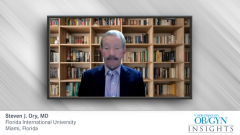
Using GnRH Agonists and GnRH Antagonists in Clinical Practice
An expert in obstetrics and gynecology comments on the utilization of GnRH agonists and GnRH antagonists in COS in IVF treatment.
Steven J. Ory, MD: In our clinic, historically, we have used the antagonists preferentially for the reasons I cited a moment ago. We saw a number of individuals who had had prior IVF [in vitro fertilization] experience and often had poor egg quality, and we did find that use of the agonists with some adjuvants was helpful in that particular setting.
There’s a great deal of variation in terms of how clinics practice. They can use agonists vs antagonists, fresh embryo transfer vs freezing all of the embryos and being a freeze-all program, utilization of PGT-A [preimplantation genetic testing for aneuploidies], the laboratory experience, the incubators, the media…. There are literally hundreds of factors that influence the success rate, and it makes comparing these individual items, agonists vs antagonists, and so forth, very difficult unless you’re introducing a very limited number of changes at 1 time and have a large volume of patients to work with to achieve an appropriate power to make those comparisons. The unfortunate reality is that many of these questions are completely unresolved. There are clinics that have outstanding success rates with a variety of different protocols and approaches.
The dose stratification pertains most to the ovarian reserve testing in the choice of gonadotropin dose. It depends on whether the patient has average ovarian reserve. In that case a more conventional stimulation might be used. For a patient with a very high ovarian reserve, such as with polycystic ovarian syndrome, a significant reduction in the gonadotropin dose would typically be considered. We know that for patients who have a low ovarian reserve, usually 450 units of gonadotropin, if there’s going to be a response, we’ll typically see it at that dose. There’s a pretty good consensus that going beyond the 450-unit dose has no additional benefit in any of those individuals who perhaps do better with a natural cycle or a low-dose stimulation, rather than go through the expense of another cycle.
There has been limited experience varying the dose of the agonist instead of antagonist. Many clinics, when they’re using an agonist, once downregulation has been achieved, they’ll cut the dose of the agonist in half, and that saves expense. As far as varying the dose of the antagonist, I don’t think there’s any convincing benefit at this point, in terms of advantage or rationale for doing that.
In the United States right now, over 80% of embryo transfers are done in frozen cycles. Typically, an antagonist would not be used in the frozen cycle. And that trend is continuing. I think an even smaller minority of fresh cycles will be done in the future. There’s also increasing interest in natural cycle where no hormones are used for the embryo transfer. Those results are encouraging, and programs are electing to use that as well.
My general recommendation would be to move to assessment of the ovarian reserve as soon as possible. Because that’s the most important question in terms of determining the patients’ prognosis, the timeline, what regimens are going to be most appropriate, and giving them a context for what can be done.
Transcript edited for clarity
Newsletter
Get the latest clinical updates, case studies, and expert commentary in obstetric and gynecologic care. Sign up now to stay informed.










